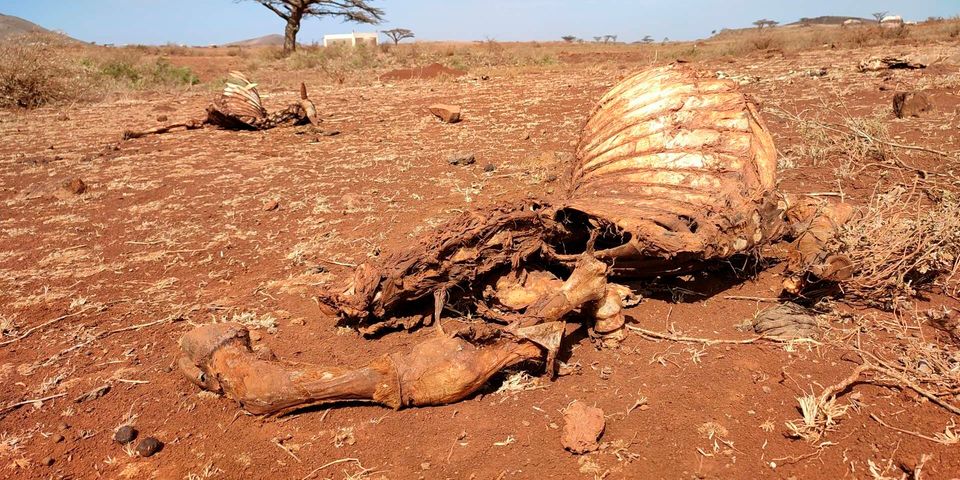
- Hits: 622
Nation Media Group : Drought situation in Kenya ASALs at crisis level: Lobby
The drought situation in the Kenya Arid and Semi-Arid Lands (ASALs) is currently at a crisis level. According to ASAL Humanitarian Network (AHN), the current drought (2020 - 2022) has been the most severe and longest; spanning five years, with widespread livelihood losses and massive displacement of populations. .
Currently, more than 4.2 million people representing 24 percent of the ASAL population are facing high levels of acute food insecurity with about 2.7 million people in the Crisis Phase and 785,000 people in the Emergency state. This, according to AHN is a 10 percent increase from the same period in 2021 when 2.1 million people were categorized as in emergency and crisis state.
According to the July-September IPC report in the 10 ASAL counties, where AHN members work, more than 40 percent of the population is facing high levels of food insecurity compared to 24 percent in all ASAL counties of Kenya. This figure is projected to increase to 47.5 percent in the period October to December 2022 and will continue to worsen over time.
“The increasing intensity and the shorter cycles between droughts is amplifying the vulnerability of the communities and their ability to cope,” said Ahmed Ibrahim-the convener of AHN, during a media briefing on Wednesday. The drought has affected crop production while pastoralist communities have lost their livestock.
More than 2.4 million livestock, which pastoralist families rely upon for nourishment and livelihood, have died in Kenya “In Marsabit County, the communities have lost more than 121,000 sheep and goats, 35,000 camels and 38,000 cattle in the last few months. The underperformance of the long rains means that pasture conditions are below average for this time of year and with forecasts of yet another below-average short rains, the situation in the ASALs will only continue to deteriorate. These circumstances negatively affect the quality and general condition of the livestock which is worsening due to increased distances to water and pasture,” said Patrick Katelo Pastoralist Community Initiative and Development Assistance (PACIDA) in Marsabit.
Tension and conflict The drought has brought tensions and conflict over limited access to resources as pastoralist communities migrate in search of water and pasture, both within the traditionally negotiated areas or outside of these locations. According to AHN, Climate change, political and economic instability, the effects of the Covid-19 pandemic plus the damage caused by the desert locust infestation have intensified and blatantly exposed, the vulnerability of the ASAL populations.
Further about 885,500 children and 986,000 pregnant and lactating mothers are acutely malnourished. “This state of malnutrition among these vulnerable populations has compromised their immunity and increased their risk of exposure to disease. The drought has further heightened the risk of gender-based violence and sexual exploitation and abuse hampering children’s access to education,” Abdija Hassan - Women for Peace and Development, Mandera County.
Also, more than 54,500 children in 17 drought-affected counties are at risk of dropping out of school unless urgent measures are taken to provide them with sufficient food and water. To cushion these families from the harsh drought condition, AHN has been running the Multipurpose cash transfer (MPCT) initiative that currently supports 26,400 households.
Also read: 45 children in Mandera County face acute malnutrition To address water, sanitation and hygiene situations, AHN has rehabilitated and solarised boreholes, and provided essential hygiene items and dignity kits for healthy menstrual management for women and girls. For those at risk of sexual and gender-based violence as a result of the drought, AHN has provided legal and medical referrals and helped the survivors with psychosocial support.
However, according to Mr Ahmed, there is much that can be done to help the over four million Kenya who has been affected by the drought. “We call upon the national and county governments to release available funding to scale up the response with both a top up to most vulnerable households to minimum household needs as well as widening the safety net program to include a larger population and to create social accountability mechanisms that will involve community humanitarian partners and stakeholders in planning, monitoring and implementation of the action,” Mr Ahmed said. The group further urged the national government and the wider humanitarian community to scale up the response beyond December 2022, in light of the anticipated below-average performance of short rains from October to December.
More focus
They want more focus given to women and young girls who are disproportionately affected by the adverse effects of the drought and put at greater risk, as they risk sexual and gender-based violence and early marriage. “Urge the national and county governments to include in their strategic plans adaptation measures that promote drought preparedness and promote alternative climate-resilient livelihood options,” Ahmed added.
They also want the government to interrogate existing opportunities for the development of more responsive Disaster Management Policies and Legislation that look into the socio-economic impact of the drought and its effect on women, youth, household incomes, pastoralists, and persons living with disabilities.



